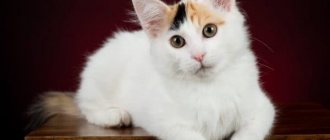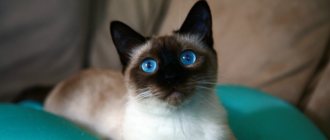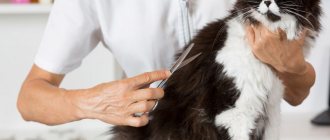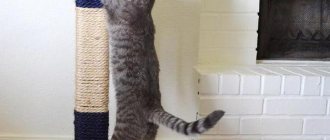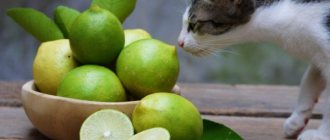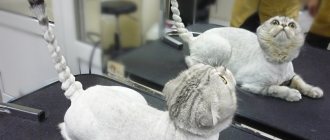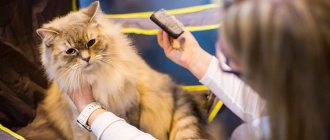Why do cats eat grass?
You have probably observed more than once how cats “graze” on lawns, eagerly eating fresh green grass, or encroaching on indoor plants, nibbling their decorative leaves. Where does this herbivorous passion come from in small domestic predators? There is no short answer to this question - although eating grass is a completely natural physiological process for many animals, the reasons for such interest in pets are different in each specific case.
Eating grass is natural and healthy for cats
To cleanse the stomach and improve peristalsis
All cats are neat people, and they spend a lot of time washing themselves, carefully licking their fur with their rough tongue. Needless to say, such commendable cleanliness also has a negative side effect: a large amount of dead hair ends up in the cat’s stomach. They are not digested, form into clumps and over time begin to interfere with normal digestion and even pose a threat to the health of the animal. This situation is especially relevant for long-haired and frequently shedding breeds.
From time immemorial, yard cats solve an unpleasant problem on their own by eating hard blades of grass - for example, wheatgrass or sedge. When such grass enters the stomach, it provokes a gag reflex - as a result, the stomach is cleared of deposits of matted wool, which comes out along with semi-digested greens. At the same time, the cat regurgitates other debris accumulated in the stomach, feathers, bone remains, etc.
It is important for cats to promptly clear their stomachs of any hair that has gotten there.
Cats, driven by instincts, perform such cleansing procedures quite often - as soon as they feel excessive heaviness in the stomach. Therefore, it is advisable that your pet has constant access to fresh and environmentally friendly grass - let him chew for his health whenever he wants. After natural cleansing, the entire digestive system will become more active:
- gastric juices will digest food better;
- useful and nutrients will be more fully and quickly absorbed by the body;
- Peristalsis is activated, intestinal function is normalized.
For treatment
Sick and weakened animals may refuse regular food, but show interest in certain herbs, somehow identifying the medicinal plants they need. Is it necessary to look for scientific explanations for such a cat phenomenon, if the talent for herbal medicine in animals is inherent in nature itself? For example, some plants have a laxative effect on the digestive system, and some, on the contrary, have a strengthening effect - and cats almost always accurately choose exactly what they need at the moment.
The components of young greens have a good effect on metabolism and oxygen saturation of tissues, which is especially useful for animals that are in the phase of active growth or recovering from an illness, as well as for pregnant cats - try to ensure that such pets do not have interruptions in fresh green grass.
As for purely medicinal plants, it is better not to rely entirely on the instinctive choice of a sick animal, but to carry out a qualified diagnosis and a course of treatment prescribed by a doctor.
With a lack of vitamins
Young fresh grass is rich in vitamins A, D and group B, minerals and biologically active substances, as well as fiber. By eating greens, cats compensate for the lack of these components in their bodies. This is especially important in the winter-spring period or in cases when the animal’s body is recovering from illnesses.
Fresh greens are a source of vitamins and minerals
Sprouts of cereals and legumes in this sense are preferable for cats, since the concentration of beneficial components in them is very high. However, you should not count on the fact that young green grass can completely cover the need for vitamins and minerals if the cat’s nutrition is not of high quality and balanced.
What is the need?
Scientists conducted research on this phenomenon and suggested the following reasons:
- to get rid of hairballs in the stomach after washing, as well as undigested food residues, because plants irritate the walls of the stomach and cause vomiting;
- to enrich the diet with vitamins, microelements, folic acid, and for this, the cat sometimes does not eat the grass, but only bites and licks the juice of the plant;
- to regulate gastrointestinal motility: as a laxative or vice versa - to counteract diarrhea, the purr finds and eats just the grass needed for this;
- just for... fun.
"Vegetable garden" for a cat
Some caring owners regularly collect fresh grass for their pets on the street and even dry it for the winter. But the benefits of such care are very doubtful. If you are not completely sure that a vitamin supplement will be harmless for your pets, it is better to grow the greens yourself, especially since it is absolutely not difficult.
Cat grass should only be collected in clean and safe places.
What grass to grow
At home, the easiest way to germinate grains of cereal plants is: wheat, oats and barley - they are distinguished by good germination and rapid development, and cats really like their juicy sprouts.
Cereal seeds are good for growing cat grass
There are a lot of useful substances in such greens, and there will definitely be no harm from them - but only if you are guaranteed to purchase seeds that have not been treated with pesticides to protect them from rodents. To play it safe, buy planting material from pet stores.
Carrot tops grown on a windowsill are a storehouse of vitamins for your cat
Of course, you can experiment and proceed from your pet’s preferences - offer him sprouts of various plants, thereby enriching the cat’s diet. But this requires certain knowledge and experience in order to choose the right “bouquet” of herbs and get a good harvest of greens.
Video: the cat chooses its own weed
Growing methods
There are a lot of nuances to growing grass for cats, as well as devices that make this already simple process easier. Let's look at the simplest, most basic method using the example of germinating ordinary wheat. The acquired skills can be confidently applied to any other seeds in order to sprout useful grass from them.
To begin with, of course, you need to choose fresh and high-quality seeds. When purchasing them in a store, pay attention to the terms and conditions of storage. If you buy wheat grains, for example, at the market, choose only whole, fresh and shiny ones - the seeds should not be crushed, damaged by pests or mold.
You can only germinate healthy and untreated wheat.
Now you can get to the fun part - turning dormant grains into living grass:
- Dry the wheat thoroughly and pour it into a glass jar with a tight-fitting lid - from here it will be convenient to take the right amount of seeds each time.
- Take a handful of beans - enough for one serving - and rinse them thoroughly with tap water.
- Spread the wet, clean grains in an even layer over the bottom of a wide, shallow bowl - it can be glass, ceramic or enamel.
- Pour unboiled water at room temperature into a bowl so that it completely covers the seeds, and leave them to swell in a warm place for two days.
- After two days, the seeds will increase in volume and small white seedlings will hatch from them - wheat can be planted.
- Rinse the sprouted grains with running water again - in our case we will plant them in the soil; Universal soil is suitable for indoor plants.
- For a mini-cat lawn, it is most convenient to take two disposable plastic bowls - in one the wheat will grow, and the second will serve as a tray where excess water will drain.
- In the bottom of the first bowl, punch several small holes for water drainage and add soil - two to three centimeters deep will be enough.
- Scatter the sprouted grains evenly over the surface of the soil and lightly sprinkle the soil on top.
- Place one bowl in another, pour plenty of water over the “crops”, cover this structure with a transparent plastic bag and place it in a bright, warm place - on the windowsill.
- In three days, when friendly shoots appear above the ground, the package can be removed - the grass lawn for the cat is ready.
The sprouts will reach full condition in another three to four days - the green treat can already be offered to the cat. This portion will last her for about a month. And all this time you will need to ensure that the soil remains sufficiently moist and the grass roots do not rot. Don’t forget to take care of the germination of the next “series” of weed in a timely manner.
This is what sprouted grass looks like on the 4th and 8th days
In a similar way, you can grow grass without soil - simply on a layer of wet cotton wool, in sawdust, or even... in wood filler for a tray. Just make sure that the cat does not use the litter for its intended purpose. But we must admit that in the soil, greens still grow faster and better, last longer and are more abundantly saturated with substances beneficial to the cat.
Some manufacturers offer these cute bowls in kits for growing herbs
To minimize effort, you can purchase a grass growing kit online or at a regular pet store. It is inexpensive, looks aesthetically pleasing and greatly simplifies the process. There are even, for example, mobile stations for germination, equipped with special massage mats for cat paws, and other original and pleasant little things.
Video: growing grass for a cat on the windowsill
Which seeds to choose
The pet industry takes into account the need of cats for fresh grass and the ever-growing demand in this area. Therefore, the range of seeds and kits for growing cat grass is increasing and becoming more diverse. We invite you to compare offers from several popular brands before making your choice.
Table: overview of herbal offerings for cats from various brands
| Trade marks | Type of grass | Method and time of cultivation | Estimated cost |
| "Horse" | herbal mixture:
| seeds are germinated in any way convenient for you in one and a half to two weeks | 13 rubles for 10 grams |
| "Chica" | oats | can be grown both in soil and without it - on a wet napkin; germination time - up to 10 days | 70 rubles for 300 grams |
| "Alpine Meadows" | a mixture of seven plant seeds:
| herbs in a vermiculite-based substrate and a convenient container grow in an average of 10 days | 80 rubles per 100 grams |
| "Aelita" | barley | grown in containers with any soil for about 8 days | 17 rubles for 20 grams |
| "Sedge" | cereal mixture | offered complete with nutrient substrate and tray; Germinates up to 10 days | 60 rubles for 30 grams |
| Trixie | barley or mixture with clover (for demanding cats and kittens) | mixtures of seeds and substrate in a ceramic bowl are germinated until ready in 5–6 days | 120 rubles for 50 grams |
| TitBit | oats | without soil - in a container and padding polyester bag - ready for use in 8 days | 60 rubles for 40 grams |
“Ready” plants for cats
In cases where the owners are especially lazy or the cat needs greens very urgently, there is also a way out. You can buy weed in the store that is already completely ready for your cat to eat. This is very convenient, and according to sellers who know the market situation, the demand for such relatively new products is growing.
Plants - mostly the same cereals or mixtures thereof - are offered in pots or trays of various sizes. The optimal dimensions of the tray for one cat are 20x20 centimeters. The grass is grown in soil or a special nutrient gel, which is harmless to the cat if it suddenly decides to eat it.
Ready-made grass in a tray is very convenient
But manufacturers still recommend not feeding grains and roots to pets, but to do this, keep the tray somewhere out of reach. Cut the grass as needed and add it to the cat's food bowl. However, many owners do not play it safe and give their pet the opportunity to feast on greens as much as he wants. Among other things, such an innovation is a real salvation for indoor plants.
Such beauty in a tray costs about 150 rubles. But you can buy the same portion of herbs for three times cheaper - sellers will simply “plant” the required amount of greens in a bag for you, and at home you will already move it into a beautiful pot or any other container of your choice.
Growing rules
There are many ways to grow grass for your pet. For example, you can take the planting technique using soil as a basis. To do this, you need to purchase the grass itself, a balanced soil mixture, and a container from a specialized store. If you don’t want to buy a pot, you can make it from scrap material.
In addition, for planting you will need polyethylene, which will completely cover the container. You can use a regular plastic bag as it. In order for the root system of plants to develop correctly, it is necessary to ensure good drainage. The seeds themselves can simply be soaked or germinated to speed up growth.
After planting, they must be sprinkled with soil and moistened with water at room temperature, sprayed from a spray bottle. Then the planted seeds should be covered with plastic film, creating a greenhouse effect. After successful shoots, the film is removed, however, if the room where the grass is grown is very dry, the sprouts will have to be covered with film for the first time. This is necessary so that they do not dry out, as this will lead to the death of the roots.
You can plant grass for cats without soil, and this method is considered simpler. To implement this, you will need two plastic plates of different sizes. The bottom of one must be pierced to create drainage and remove excess water. The holed plate is placed inside the whole one so that it does not rest entirely on the bottom.
A little cotton is placed on the bottom, then the cotton is moistened, and after that the seeds are laid on it. The seeds are covered on top with gauze with large holes through which sprouts can grow. To speed up germination and prevent drying out, cover the top of the plate with plastic wrap. The method is convenient because, even if they want to, the pets will not scatter the soil, and in addition, the breeder will not have to prepare a substrate for planting.
For an improvised lawn, instead of a substrate, you can use a certain cat litter (for example, from compressed sawdust). It is soaked until a homogeneous consistency is obtained, after which it is used as soil. Otherwise, the method is no different from the option of planting in a pot with soil.
After the shoots appear, the grass needs to be provided with proper care, which will accelerate its growth and affect rapid rooting, as well as juiciness.
- You will have to water the soil daily, but so that it does not stand in water. At first, it should be moistened with a fine water spray. Water for irrigation must be filtered or boiled.
- Do not place the container with sprouts in a hot place, as this will lead to rapid evaporation of water from the soil (cotton wool, filler).
- The location for the container must be chosen correctly: drafts that can freeze the grass are unacceptable (relevant in winter for plants located on the windowsill).
- Cat grass takes an average of 2 weeks to grow. There is no need to grow grass for months: after the deadline, it will begin to age, lose its juiciness, it must be renewed so that the cat always has a fresh portion.
- The layer of soil that is sprinkled on the grass when planting should not be thick, otherwise it will be difficult for the seeds to germinate through the soil. In addition, with a large layer, germination will take a long time. It is a mistake to assume that it should be up to 3 cm: ideally 1 cm is enough.
- Lack of light and temperature during cultivation will result in stunted grass. For optimal growth and succulence, it needs to be provided with all aspects of care, including not only watering, but also light and moderate temperature.
- In summer, you can grow grass on a windowsill or outside. However, it is worth considering that it will have to be treated to remove dust so that the pet does not inadvertently eat it along with the necessary substances.
- To speed up germination, the seeds selected for planting can be soaked in water. Soaking time usually does not exceed 2 hours. The water should not be too hot; it is advisable to use settled or filtered water.
Cats crave mint and valerian
The amazing affection of cats of all types and breeds for valerian and catnip has always attracted the attention of people. These completely different plants contain special pheromones, which attract both pets and wild predators. Such cat passion can turn out both to the benefit of animals and to their detriment.
Cat mint
The very name of catnip (or catnip) indicates the special attitude of cats to this inconspicuous perennial grass, which grows everywhere like a weed: in meadows and parks, wastelands and vegetable gardens.
Catnip grows up to a meter in height, has jagged leaves characteristic of all types of mint and modest inflorescences of various shades - white, pink, purple. The peak of flowering occurs in mid-summer - during this period the grass is harvested, if necessary.
Catnip is usually harvested during the flowering period
The organic compound nepetolactone is the main component of the essential oil, which determines the attractiveness of the plant to adult cats. Immature kittens are not interested in this natural pheromone, but sterilized animals react to it differently, but most often in the same way as before the operation. Older animals become indifferent to the delights of catnip.
It is curious that this passionate attachment is genetic in cats and cats and is inherited. That is why there are some adult individuals who do not react at all to the “magical” smell of catnip.
By influencing those areas of the brain that are responsible for the emotional sphere, nepetolactone causes mild, but very pleasant hallucinations for the animal - obviously of an erotic nature. Cats do not develop any addiction, much less dependence on this substance, so catnip can be considered a safe plant for them. But prolonged exposure to nepetolactone in especially emotional people can lead to overexcitation and even disorders of the nervous system.
The effect of this herbal aphrodisiac is short-lived and usually lasts no longer than a quarter of an hour. Then it will take at least forty minutes before the cat becomes receptive to it again.
For most cats, catnip evokes pleasant visions.
Catnip can be used either fresh or dried, or as infusions; Pet stores sell ready-made preparations based on the extract of this herb. The properties of catnip are used for various purposes:
- improve appetite;
- trained to use the tray;
- switch attention from scratching wallpaper and furniture to the scratching post;
- processing new toys.
Interestingly, catnip essential oil is hated by some household pests and unwanted insects:
- rats;
- mice;
- cockroaches;
- mosquitoes
By the way, valerian officinalis and drugs based on it have the same properties.
Video: What a cat is willing to do to get catnip
Valerian
Valerian officinalis is popularly called cat herb - almost all adult cats react violently to this plant. The effects of pungent valerian on cats are similar to the effects of catnip on them - but in this case you need to be more attentive and careful. An overdose of the enzyme actinidin contained in the herb and especially the roots of valerian can lead to undesirable consequences.
Valerian officinalis is a tall herbaceous plant with carved leaves and umbrella-shaped inflorescences.
This beautiful perennial plant reaches a height of one and a half meters. It blooms with spectacular white “umbrellas” almost throughout the warm season. All parts of the plant can be harvested, but its roots contain the highest concentration of active substances.
The plant substance is identical to one of the odorous components of cat urine and acts on adult cats as a powerful aphrodisiac, changing for a short time not only their emotional but also hormonal balance. This can pose a serious danger to the animal and cause the following unpleasant side effects:
- convulsions;
- strong secretion of saliva and foam from the mouth;
- clouding of consciousness;
- difficulty breathing, even stopping;
- stroke.
A cat that has tasted valerian or catnip may behave inappropriately
Actinidin has an exciting effect on cats - they behave as if they are in a state of drug intoxication and get great pleasure from it. But this creates a huge load on the nervous system, and if it is unstable, then you should not abuse valerian under any circumstances - it is definitely not fun.
Don't give valerian to your cat just for fun.
The valerian plant is unlikely to cause harm to your pet, but medications that contain concentrated actinidin can become a source of danger for the cat. There are strict contraindications for the use of alcoholic extracts of valerian:
- increased excitability;
- kidney and liver pathologies;
- periods of pregnancy and lactation.
Valerian is dangerous for a pregnant cat
But valerian in moderate doses is very useful for digestion. The fact is that this herbal medicine also has the property of relaxing smooth muscles, which helps relieve spasms and colic in the gastrointestinal tract. Veterinarians also prescribe valerian preparations in the complex treatment of cardiovascular diseases and thyroid problems. You must strictly adhere to the doctor's recommendations and dosage of medications.
Scientists studying the life of wild cats in nature often use valerian tincture to lure the animals closer.
Some other plants can have an effect similar to valerian and catnip on representatives of the cat family:
- peppermint;
- thyme;
- lemongrass;
- Melissa;
- honeysuckle.
Video: cat eats dried valerian
Are herbs always beneficial?
Cats living in nature or on the street usually instinctively choose the right herbs for medicinal or cleansing purposes. Pets do not have this experience, and their instincts are most often somewhat muted. There is a high risk for them to chew grass that is hazardous to their health while walking.
Even a plant that is safe in its composition can cause considerable harm if it grows in a polluted area - on roadsides or near industrial enterprises. In addition, there is no guarantee that this grass is not contaminated with helminth eggs or contaminated by the feces of a sick animal.
Not all outdoor grass is good for your pet.
If the animal does not leave the house and does not receive the necessary greenery in the required quantities, then it may well switch to nibbling indoor plants, some of which may be very poisonous. As a result - various troubles, even death, and specifically the following side effects:
- uncontrollable vomiting;
- digestive disorders;
- pain and cramps;
- renal, heart or pulmonary failure.
Common houseplants can cause serious harm to a cat.
Here are some houseplants to keep out of your cat's reach:
- amaralis;
- asparagus;
- geranium;
- dieffenbachia;
- caladium;
- lily of the valley;
- spurge;
- narcissus;
- oleander;
- ivy;
- spathiphyllum;
- physalis;
- ficus;
- philodendron;
- Cyperus;
- cyclamen.
Offer your pet only safe green treats.
Video: which plants can be dangerous for a cat
What to grow?
In most cases this
- sprouts of cereals: oats, wheat, millet and rye, but only young shoots no more than 25-30 cm high are useful (and for humans too!);
and other types:
— many people love lemongrass; it is up to 1 m high, action: sedative, diuretic, antiseptic;
- catnip prefers to grow on the sunny side, is a powerful antibiotic, and its phytohormones stimulate a “feeling of happiness”;
— parsley is very useful: it contains vitamins A, B, C;
— marigolds and violets enjoy attention;
— some people like peppermint so much that they need to be careful not to overeat it and upset the stomach; although almost always tailed animals intuitively know exactly what and in what quantity should be “pinched” from the pots.
- valerian, the greenery of which, although valued by animals, is difficult to grow at home, and in addition, it is necessary to find out exactly from specialists about the dangers of preparations made from it.
Veterinarians advise specially crumbling it into food as a useful dietary supplement (for the sake of vitamins and fiber) only if there is a complete lack of interest in greens.

